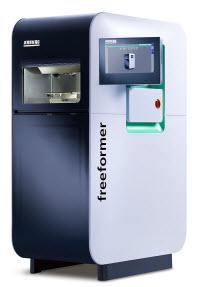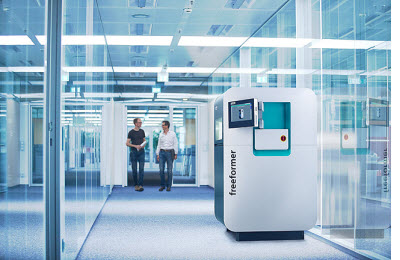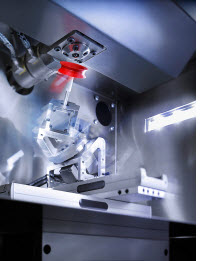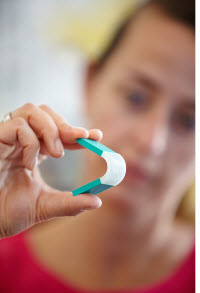Issue 47
Subscribe Now
Featured Interview in K 2013: ARBURG GmbH Co KG
A new era in plastics processing
• World premiere: Arburg will present a groundbreaking invention for additive manufacturing at the K 2013
• Arburg Plastic Freeforming (AKF): functional parts from plastic droplets
• Freeformer: with 3D CAD files and without a mould for one-off parts and small-volume batches from standard granulate
Lossburg. Arburg has always had a major influence on injection moulding technology and driven it forwards. It all began in the 1950s with the development of the first Arburg injection moulding machine for the reliable overmoulding of small parts with plastic. Further milestones were achieved in the following years, such as the Allrounder with a swivelling clamping unit and interchangeable injection unit, two-colour injection moulding and the Selogica control system. Thanks to these and other inventions, the company has gained an outstanding reputation in the global injection moulding industry. With the world premiere of the Freeformer at the K 2013, this success story will be continued and transferred to additive manufacturing.
As an innovative machine manufacturer, Arburg has worked intensively on the additive manufacturing of plastic parts. The result is an astounding, unique machine, the Freeformer, and a new process, the patented Arburg Plastic Freeforming (AKF).
Completely free: plastic formed without tools
As the name suggests, no moulds or predefined cavities are required for plastic freeforming.
With AKF, 3D CAD files are processed directly by the Freeformer, standard plastic granulate is melted in an integrated manner as in injection moulding, droplets are generated from the liquid melt, and from these the fully functional component is built up additively, i.e. layer-by-layer. This enables the cost-effective individual manufacture of parts completely without injection moulding moulds as from batch sizes of a single unit.
Practice-oriented: Ideas of a machine builder
As a manufacturer of injection moulding machines, Arburg has taken a practical look at additive manufacturing and has redeveloped and consistently implemented the concepts in the form of the unique AKF process. First of all, it was important to be able to use conventional plastic granulates rather than prefabricated forms of supply such as powders or strands, which make the material, the processing and therefore also the parts expensive. Low material consumption was also important, as the Freeformer can operate without support structures and therefore produces no waste. This saves on resources and allows cost-effective production. This makes highly flexible manufacture of functional parts is therefore possible.
Conventional: processing of standard granulates
There is no need to re-invent the wheel. This is what the Arburg technicians also thought when developing the Freeformer. They provided the new machine with conventional, i.e., tried and tested, material processing, which operates essentially in the same way as injection moulding. The machine is filled with standard plastic granulate. A heated plasticising cylinder ensures an optimally prepared plastic melt in the so-called discharge unit. Its patented nozzle closure with high-frequency piezo technology enables fast opening and closing movements to produce the plastic droplets under pressure, from which the required plastic part is additively built up “droplet-by-droplet”.
Innovative: movable component carrier, stationary nozzle
The principle of moving and stationary machine components was re-thought. In the Freeformer, the discharge unit remains with its nozzle precisely in a fixed vertical position. The component carrier moves instead. In addition to a standard component carrier that can move along three axes, a version with five axes is available, e.g. for implementing undercuts without the need for a support structure.
The major advantage of the 5-axis version is that support structures of the type required in many other additive manufacturing processes are generally superfluous. Following their manufacture, the components are immediately ready for use without reworking.
Unique: additive hard/soft combinations
The high degree of processing flexibility was one of the main criteria taken into account during the development of the Freeformer. This means, for example, that two materials or colours can be processed with one Freeformer equipped with two discharge units. As a result, e.g. even movable hard-soft combinations or parts with a special appearance or texture can be produced, in which both components are securely joined.
Ingenious: complex technology, simple to use
Finally, with the Freeformer, Arburg followed strictly the same approach as with its injection moulding machines, making complex technology simple to use and developing it in-house. This makes additive manufacturing ingeniously simple. The parameters required for the comprehensive construction of the parts are generated using the in-house-developed Freeformer control system. This receives the 3D CAD data for the components to be manufactured in the form of STL files, processes it automatically through slicing, and production can start. No special programming, processing knowledge or extensive training is required. The gesture-controlled multitouch screen makes working with the machine even more enjoyable. Effortless, trouble-free manufacture of parts is “simply” loads of fun with the Freeformer.
Clean: free from dust and emissions
The components are produced on the Freeformer by the liquid droplets, completely free from dust and emissions. The machine is therefore suitable for virtually any application environment. Whether in production, in the office, in the design department or in a clean medical technology environment. No extraction or filtering equipment is required.
Plug-and-play technology means that the Freeformers are mobile and can be used universally. The machine is not only highly compact, but also immediately ready for production: Just plug it in and start manufacturing the parts.
Production efficiency: now also for one-off parts and small-volume batches
The implementation of the Freeformer takes Arburg one step further towards the broadening of overall production requirements in plastics processing. While customers have always been able to rely on the company’s expertise in injection moulding and therefore high-volume production of plastic parts, as of now the same applies to the cost effective production of small batches down to one-piece flow. Quality at low unit costs and therefore production efficient manufacturing now also enter the field of additive manufacturing. Regardless of the industry, the new Freeformers and Arburg Plastic Freeforming (AKF) offer exactly the same new freedom to all customers, from the automotive industry through to medical technology or the consumer goods sector. Completely new fields of application are also likely. Two of the revolutionary new machines on which one-component and two-component parts are manufactured will be on show at K 2013.
Anyone examining them and their operating principle more closely will see that the slogan used by the company to advertise its Freeformer is no exaggeration: Form your world freely!
• World premiere: Arburg will present a groundbreaking invention for additive manufacturing at the K 2013
• Arburg Plastic Freeforming (AKF): functional parts from plastic droplets
• Freeformer: with 3D CAD files and without a mould for one-off parts and small-volume batches from standard granulate
 |
|
The Freeformer heralds a new era in plastic processing – the additive manufacturing of functional components as one-off parts and small-volume batches. |
As an innovative machine manufacturer, Arburg has worked intensively on the additive manufacturing of plastic parts. The result is an astounding, unique machine, the Freeformer, and a new process, the patented Arburg Plastic Freeforming (AKF).
Completely free: plastic formed without tools
As the name suggests, no moulds or predefined cavities are required for plastic freeforming.
With AKF, 3D CAD files are processed directly by the Freeformer, standard plastic granulate is melted in an integrated manner as in injection moulding, droplets are generated from the liquid melt, and from these the fully functional component is built up additively, i.e. layer-by-layer. This enables the cost-effective individual manufacture of parts completely without injection moulding moulds as from batch sizes of a single unit.
Practice-oriented: Ideas of a machine builder
As a manufacturer of injection moulding machines, Arburg has taken a practical look at additive manufacturing and has redeveloped and consistently implemented the concepts in the form of the unique AKF process. First of all, it was important to be able to use conventional plastic granulates rather than prefabricated forms of supply such as powders or strands, which make the material, the processing and therefore also the parts expensive. Low material consumption was also important, as the Freeformer can operate without support structures and therefore produces no waste. This saves on resources and allows cost-effective production. This makes highly flexible manufacture of functional parts is therefore possible.
Conventional: processing of standard granulates
There is no need to re-invent the wheel. This is what the Arburg technicians also thought when developing the Freeformer. They provided the new machine with conventional, i.e., tried and tested, material processing, which operates essentially in the same way as injection moulding. The machine is filled with standard plastic granulate. A heated plasticising cylinder ensures an optimally prepared plastic melt in the so-called discharge unit. Its patented nozzle closure with high-frequency piezo technology enables fast opening and closing movements to produce the plastic droplets under pressure, from which the required plastic part is additively built up “droplet-by-droplet”.
Innovative: movable component carrier, stationary nozzle
The principle of moving and stationary machine components was re-thought. In the Freeformer, the discharge unit remains with its nozzle precisely in a fixed vertical position. The component carrier moves instead. In addition to a standard component carrier that can move along three axes, a version with five axes is available, e.g. for implementing undercuts without the need for a support structure.
The major advantage of the 5-axis version is that support structures of the type required in many other additive manufacturing processes are generally superfluous. Following their manufacture, the components are immediately ready for use without reworking.
 |
| The mobile Freeformer operates quietly, efficiently, free of dust and emissions. This means that it is suitable for use not just in production, but also in the office or design department, for example. |
Unique: additive hard/soft combinations
The high degree of processing flexibility was one of the main criteria taken into account during the development of the Freeformer. This means, for example, that two materials or colours can be processed with one Freeformer equipped with two discharge units. As a result, e.g. even movable hard-soft combinations or parts with a special appearance or texture can be produced, in which both components are securely joined.
Ingenious: complex technology, simple to use
Finally, with the Freeformer, Arburg followed strictly the same approach as with its injection moulding machines, making complex technology simple to use and developing it in-house. This makes additive manufacturing ingeniously simple. The parameters required for the comprehensive construction of the parts are generated using the in-house-developed Freeformer control system. This receives the 3D CAD data for the components to be manufactured in the form of STL files, processes it automatically through slicing, and production can start. No special programming, processing knowledge or extensive training is required. The gesture-controlled multitouch screen makes working with the machine even more enjoyable. Effortless, trouble-free manufacture of parts is “simply” loads of fun with the Freeformer.
Clean: free from dust and emissions
The components are produced on the Freeformer by the liquid droplets, completely free from dust and emissions. The machine is therefore suitable for virtually any application environment. Whether in production, in the office, in the design department or in a clean medical technology environment. No extraction or filtering equipment is required.
Plug-and-play technology means that the Freeformers are mobile and can be used universally. The machine is not only highly compact, but also immediately ready for production: Just plug it in and start manufacturing the parts.
Production efficiency: now also for one-off parts and small-volume batches
The implementation of the Freeformer takes Arburg one step further towards the broadening of overall production requirements in plastics processing. While customers have always been able to rely on the company’s expertise in injection moulding and therefore high-volume production of plastic parts, as of now the same applies to the cost effective production of small batches down to one-piece flow. Quality at low unit costs and therefore production efficient manufacturing now also enter the field of additive manufacturing. Regardless of the industry, the new Freeformers and Arburg Plastic Freeforming (AKF) offer exactly the same new freedom to all customers, from the automotive industry through to medical technology or the consumer goods sector. Completely new fields of application are also likely. Two of the revolutionary new machines on which one-component and two-component parts are manufactured will be on show at K 2013.
Anyone examining them and their operating principle more closely will see that the slogan used by the company to advertise its Freeformer is no exaggeration: Form your world freely!
 |
 |
|
In Arburg Plastic Freeforming, standard granulate is first melted. The functional part is then produced layer-by-layer from plastic droplets via a clocked nozzle and a movable component carrier. |
An appropriately equipped Freeformer can be used to process two materials or colours in combination. This means, for example, that movable hard/soft combinations can be produced on an additive basis. |



